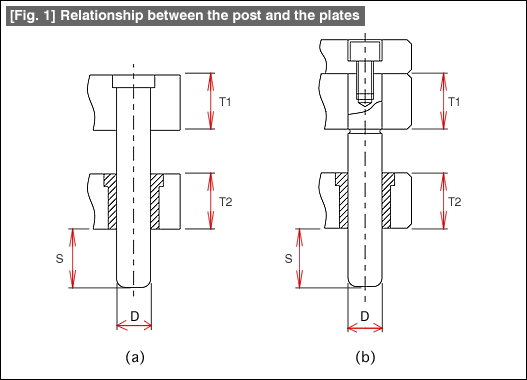#077 Method of Using Standard Components (26) Stripper Guide - 5: Method of Using a Stripper Guide Post
By the stripper guide post penetrating through the plates, the mutual relationship between the plates is restricted, and hence the relationship is maintained. It is desirable that the maintained relationship does not change even when the punch and die set is operating, and is maintained in the initial state. Because of this, it is necessary to take care about the relationship between the plates and the guide post. Their dimensional relationship is shown in Fig. 1.

While (a) is a flange stopping type post and (b) is a screw type post, both are the same. In the relationship between the post and the plates, the minimum value of the plate thicknesses (T1 and T2) relative to the post diameter (D) is that they are equal (D = T), and usually the plate is made thicker than the post diameter. Although the maximum thickness is about 3 times the diameter of the post, usually the plates are not made this thick. The figure of "3 times" is a guideline so that it is possible to drill the hole economically and accurately. The relationship between the hole diameter and the depth is not only a problem with guide posts, but is the same with the holes for knock pins (dowel pins), etc. Deep holes requiring accuracy become harder to drill and are not good. There is also not much meaning in terms of accuracy.
One other problem is that of by how much is the tip of the post to be made longer than the plate. Usually, the post enters inside the hole in the die plate, thereby creating the relationship between the top mold and the bottom mold. At this time, the question is how deep should the post enter in order to maintain accuracy. Although there are some dies in which the post has been made quite small because the post can easily bite into the hole, this can be a method of use that ruins the function of the inner guide. It is good if the length of protrusion from the plate is as long as possible, and a guideline for this length is about 1.5 to 2 times the diameter of the post. In the case of a press machine with a short stroke length, it is good to make the length long enough so that the inner guide does not come out of the die plate even at the top dead point of the press machine. The purpose of making this long is to make it strong against eccentric loads. The above discussion is given assuming that there are four posts, and the effect becomes still higher when the number of posts is increased to, say, six or eight posts.
- #167 Problems in Punching and their Countermeasures (6) Scrap Processing in Punching
- #166 Problems in Punching and their Countermeasures (5) Trimming of Drawn and Shaped Parts
- #165 Problems in Punching and their Countermeasures (4) Scrap Clogging in Punching
- #164 Problems in Punching and their Countermeasures (3) Bending and Twisting of Narrow Punched Parts
- #163 Problems in Punching and their Countermeasures (2) Bending due to Punching



